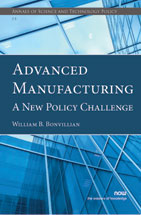Advanced Manufacturing: A New Policy Challenge
By William B. Bonvillian, Massachusetts Institute of Technology, USA, bonvill@mit.edu
Abstract
In 2016 the political system experienced significant disruption in part due to a working class voting block suffering from a long decline in American manufacturing, which became particularly acute in the decade of the 2000s. Manufacturing employment fell by one-third in this period, 64,000 factories closed, manufacturing capital investment and output suffered, and the productivity rate dropped. The U.S. had been systematically shifting production abroad, and experts began to realize as the next decade began that the decline in its production capability was starting to affect its innovation capacity — which had long been viewed as its core economic strength.
This article reviews the origins of the policy response to this dilemma, which came to be called “advanced manufacturing.” Implementation has just begun and the next several years should reveal whether these policies could begin to have an effect on American manufacturing decline. The article traces the way the foundational concepts were developed in a series of reports from in and out of government. It explores how, for the first time, an innovation system response was considered and developed to strengthen the U.S. production system. It examines the key new policy mechanism created by the administration and supported by Congress, the manufacturing innovation institutes, a complex public–private collaborative model to develop new production technologies and processes, with supporting workforce education. It reviews how the new institutes are working, lessons learned as they have started up and possible enhancements that could expand their policy reach.
While this model may create efficiencies and productivity gains to help put existing U.S. manufacturers back in competition with lower cost and lower wage competitors abroad, the article finds there is a second problem. The U.S. developed in the 1980s and 1990s a new innovation system based on venture capital for entrepreneurial startup firms for implementing the IT and biotech innovation waves. That venture system has now largely shifted to support software firms, and has abandoned startups planning to manufacture “hard” technologies. In effect, the U.S. is fencing off firms that manufacture from its venture-based innovation system. This is now driving the next generation of manufacturers to production abroad, which will have significant societal consequences longer term. This article reviews new models to tackle this problem, essentially substituting technology and know-how rich spaces for capital.
These new approaches — an advanced manufacturing program — if implemented, could play a role in reconstituting the manufacturing sector, broaden the startup model, and start to reverse the serious social disruption the manufacturing decline has led to.
Advanced Manufacturing: A New Policy Challenge
After a long decline in American manufacturing in the 2000s — manufacturing employment fell by one third, 64,000 factories closed, manufacturing capital investment and output suffered, and the productivity rate dropped during this period. Simultaneously, the U.S. had been systematically shifting production abroad, and the decline in production capability was starting to affect innovation capacity — which had long been viewed as a core strength of the U.S. economy.
Advanced Manufacturing: A New Policy Challenge reviews the origins of the policy response to this dilemma, which came to be called “advanced manufacturing.” It traces the way the foundational concepts were developed in a series of reports from in and out of government. It explores how, for the fi rst time, an innovation system response was considered and developed to strengthen the U.S. production system. It examines the key new policy mechanism created by the Administration and supported by Congress, the manufacturing innovation institutes, a complex public-private collaborative model to develop new production technologies and processes, with supporting workforce education.It reviews how the new institutes are working, lessons learned as they have started up and possible enhancements that could expand their policy reach.
While this model may create effi ciencies and productivity gains to help put existing U.S. manufacturers back in competition with lower cost and lower wage competitors abroad, there is a second problem — the U.S. innovation system based on venture capital for implementing the IT and biotech innovation waves of the late 20th century now largely shifted to support software fi rms, abandoning manufacturing startups. This is now driving the next generation of manufacturers to production abroad, which will have signifi cant societal consequences longer term. This monograph reviews new models to tackle this problem, essentially substituting technology and knowhow rich spaces for capital.
